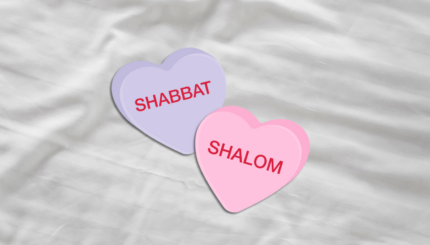Jews read sections of the Torah each week, and these sections, known as
parshiyot, inspire endless examination year after year. Each week we will bring you regular essays examining these portions from a queer perspective, drawn from the Torah Queeries online collection, which was inspired by the book Torah Queeries: Weekly Commentaries on the Hebrew Bible. This week, Andrew Ramer considers the “queer” power of talking animals, and the blessings and curses they can bear.
Creative Commons/muffinimal
The American Heritage Dictionary says this of Queer:
1. Deviating from the expected or normal; strange; a queer situation.
2. Odd or unconventional, as in behavior; eccentric.
3. Of questionable character or nature, suspicious.
All of this could describe the talking she-ass who appears in this week’s parasha: unexpected, unconventional, of questionable nature. Parrots and myna birds can mimic human speech. Chimps and gorillas have been taught to sign in human languages. King Solomon was said to be able to understand the languages of the animals. But a talking she-ass is something else all together.
Talking animals are found in every culture, from Aesop’s fables to Mickey Mouse, Donald Duck, Miss Piggy, the cowardly lion of Oz, and even several talking donkeys: Eeyore in Winnie the Pooh, Benjamin in Animal Farm, and the talking donkey in the Shrek films. But in all of the Torah there are only two talking animals, the serpent in Eden and now our donkey. Just as Parashat Shelach Lecha calls to mind Parashat Lech Lecha, I believe we’re supposed to think about the serpent when we read this portion. The serpent led the first human beings astray, separating them from their primal garden home,while the she-ass carried Balaam the son of Beor toward blessing the Israelites with words we recite to this day: “Mah tovu: How goodly are your tents, Jacob; your dwellings, Israel.” (Numbers 24:5)
Balaam’s blessing occurs in a parasha unlike any other in the Torah. Several rabbinic sources consider it to be a separate book of Torah all together. An ancient text uncovered in 1967 in Jordan contains fragments of the prophecies of Balaam the son of Beor, making him one of the few characters in the Torah to be mentioned in non-Biblical sources. The Balaam in this week’s parasha, in agreement with the uncovered inscriptions, was a pagan prophet hired by Balak the king of Moab to curse the Israelites. Balaam set out to meet Balak on his loyal she-ass, who swerved off the path through a vineyard — to avoid the angel with a drawn sword who was blocking her way. Balaam couldn’t see the angel and beat the she-ass three times, trying to get her to go back on the path. Unwilling to do so, she turned to Balaam and said, “What have I done to you that you have beaten me?” (Numbers 22:28) To which Balaam replied, “You have made a mockery of me! If I had a sword with me, I’d kill you.” (Numbers 22:29). The angel then revealed itself to Balaam and made it clear to him he can continue on, with the understanding that he will only say what he’s told to say — blessings, not curses.
These lines from an Inuit poem by Nalungiaq collected in the 1920s offer a window into this parasha:
In the earliest time, when both people and animals lived on earth,
a person could become an animal if he wanted to
and an animal could become a human being.
Sometimes they were people and sometimes animals
and there was no difference.
All spoke the same language.
That was the time when words were like magic.
The human mind had mysterious powers.
A word spoken by chance might have strange consequences.
It would suddenly come alive
and what people wanted to happen could happen —
all you had to do was say it.
Nobody can explain this:
That’s just the way it was.
But we don’t live in the earliest time. The division between human and animal is firmly established, hierarchical, an institutionalized apartheid. We are higher, they are lower. But sometimes something queer happens. Someone crosses the rigid divide. And when that happens, we are for a moment linked back to primeval wholeness once again. A talking animal wasn’t necessary in this story. Another human being could have served the same role, seeing the angel in the vineyard that Balaam couldn’t see. But this is a division-disruptive tale, tucked into a Torah that likes its separations, between night and day, male and female, animal and human. For who among us still has the ability to move back and forth between genders, between time and worlds? In earth-connected cultures it’s the shamans who do that. In our modern world, shamans are very rare. It’s we queers who walk between worlds, between genders, between cultures and desires, who link and unite, who make one from many. Whenever I read this parasha, and come to the poor nameless she-ass being abused by her human but inhumane master, I think of our queer shamanic selves. We are reviled by the dominant culture for our “animal” impulses, but like the she-ass, we are often far more capable of seeing the angels that surround us than they are, who claim to be in alignment with Scripture, in direct communication with God, and holier than everyone else.
Comic on one level, this parasha, with its female protagonist, is a tale of great power. Our ancestors understood this. Tradition tells us that the donkey’s mouth was one of ten things created by God in the very last moments before the very first Shabbat, including the rainbow, Miriam’s well, the manna that later fell from heaven, and the worm which ate through the stones used to build Solomon’s temple, so that they weren’t cut by anything metal that might resemble a weapon. Comic and holy at the same time — when animals talk, we must always pay attention. The boundaries between worlds are coming down. The primal Truth is about to be revealed. The sacred is queerly manifest in a vineyard, shining and proclaiming the way. Spirit and matter are once again united, as they were in earliest times. And through this union we are reminded that separations are temporal, temporary. And as Nalungiaq, the Inuit poet reminds us, words can have great power. As we read and speak of Torah in this queer way, we make things happen that may have been hidden away since just before the very first Sabbath. We build new houses, new shrines. We are witness to the sacred in all things. One moment we are wandering lost through the fields of the world — then suddenly we see, hear, and understand once again that all is One.
Torah
Pronunced: TORE-uh, Origin: Hebrew, the Five Books of Moses.


